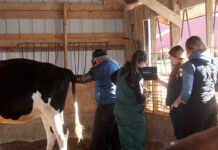This has nothing to do with “Rusty Iron,” but I’m taking the liberty of commemorating the 200th anniversary of the start of a mostly forgotten U.S. war, as well as the service in that long ago conflict of two of my ancestors.
On June 18, 1812, the U.S. Congress passed a bill declaring war on Great Britain, and President James Madison signed it the same day.
‘The lust of power.’
The reasons given were the “…mad ambition, the lust of power, and commercial avarice of Great Britain…” in her quest for complete domination of the oceans.
William Henry Harrison, governor of Indiana Territory, commanded what was then called the “Western Army,” responsible for Indiana and Michigan territories and the state of Ohio.
Both sides in the war recognized the importance of Lakes Ontario and Erie, so Harrison was ordered toward Detroit, then in British hands.
Dissension in the ranks
In 1812, the United States had a regular army of less than 12,000, with few trained officers. Each state had a militia and it was expected that these forces would be used to do the fighting.
The war was unpopular in the East, especially in New England, and militia units from those states refused to serve, except to defend their own states from enemy attack.
The British weren’t much better off, with most of their army and navy busy fighting Napoleon in Europe.
President Madison was determined to invade Canada and, after the Americans suffered several defeats at various points along the border, he asked for volunteers from Pennsylvania and Virginia to join those from Indiana, Illinois and Kentucky, plus some newly recruited regulars, in Harrison’s Western Army for the attempt to retake Detroit and then a thrust into Canada.
After a lot of skirmishing with British troops and Indians, and a serious defeat at the Battle of Frenchtown (now Monroe, Mich.), part of Harrison’s army reached the Maumee River in northwestern Ohio.
Family connection
At this point, two of my ancestors on my mother’s side of the family entered the story.
William Blaney and John Ganoe were born in 1780 and were my multiple-great- grandfathers. John’s son married William’s granddaughter and their son was my maternal grandfather. Both men lived in Fayette County, Pa., and entered federal service in October of 1812.
John Ganoe belonged to the “Fayette Greens,” a militia company commanded by Capt. Peter Hertzog, while William Blaney was in Capt. Joseph Yeager’s company. Both units were assigned to the 2nd Regiment, under Lt. Col. Richard Patterson, of Brig. Gen. Richard Crooks’ 2nd Pennsylvania Brigade and were enlisted for six months.
West from Pittsburgh
The brigade was organized at Pittsburgh, and began a long march to join the Army of the Northwest on Oct. 19, 1812. From Pittsburgh the brigade headed west toward Lisbon, Ohio, and then on to Canton.
By Nov. 3, the brigade was in Wooster and on Nov. 13, entered Mansfield.
From here, the brigade split, with Hertzog’s and Yeager’s companies assigned to a battalion ordered to the Maumee River rapids southwest of Toledo where they helped build Fort Meigs near presentday Perrysburg.
Injured
While the 2nd Pennsylvania Brigade did no fighting while there, and was discharged from the Army of the Northwest April 2, 1813, Grandfather Blaney received a serious injury that handicapped him the rest of his life.
In 1854, William Blaney, an illiterate blacksmith nearly 74, appeared before a justice of the peace in Uniontown, Pa., to apply for a disability pension based upon his Army service. His affidavit, which he signed with his mark tells the sad tale.
After reaching Fort Meigs, Blaney was part of a scouting party that in February was ordered to go about 20 miles up the Maumee River to a small village called Priskeel (?), to retrieve two small boats to be used when the ice melted in the spring. The plan was to load the boats on sleds that would be pulled back to Fort Meigs on the river ice by the men.
As the party traveled back down the river on the ice, picture the men with ropes over their shoulders straining to move the heavy sleds. While doing this, Private Blaney’s feet slipped and he fell heavily forward, striking the ice on the left side of his face, fracturing the cheek bone.
The 1854 document reads: “Deponent (Blaney) says that he suffered severely from said fracture for a month or six weeks — the left side of his face was swelled very much — and for several Months thereafter he could only eat soft food — and in fact…has never since been able to eat any hard food.”
The deposition went on: “Ever since …he has suffered severely and frequently from Rheumatism and Neuralgia in his face and head…that sometimes — as he is now quite old — he has attacks of Rheumatism in his back or limbs — and that these attacks now occur so frequently — causing him such extreme pain — and general Debility of Body — that he is totally unable to obtain a subsistence from manual labor.
“Deponent further saith that he is very poor — that he will be aged seventy four years of age on the 10th Day of March — that he has no other occupation than that of Blacksmithing which he is now unable to do…that he has an aged wife — utterly helpless from years and infirmities — depending upon himself and the charity of the community.”
Unfortunately, the muster rolls of the companies of both Capts. Yeager and Hertzog carried Pvt. Blaney as “present” with no reference to an injury, so the pension was denied.
In one deposition, Blaney, with some pride I believe, said that after his injury and until his discharge “…he continued to attend to his duties as a soldier as well as he could.” Perhaps had he reported himself sick the records would have supported his pension request.
The Fayette County property tax rolls for the last six years of his life show he had no property and virtually no income, so in 1859 the old soldier with the misshapen face died a pauper.













I also have a multi-great grandfather that served in the Fayette Greens, Moses Hopwood. He was a private under Cpt. Hertzog. I’ve been trying to find out more about them, and appreciate your story. Thank you.
Interesting read. I’ve been looking through my line and I believe your great-great John is mine as well. I am part of his daughter Catherine’s family, according to the cemetery database! Nice to know more about my history.
My husband is William Blaney’s great-great-great grandson. I am grateful for the information in this article, as I continue to research his family.
Where is this cemetery and name
Which cemetery as I have searched many